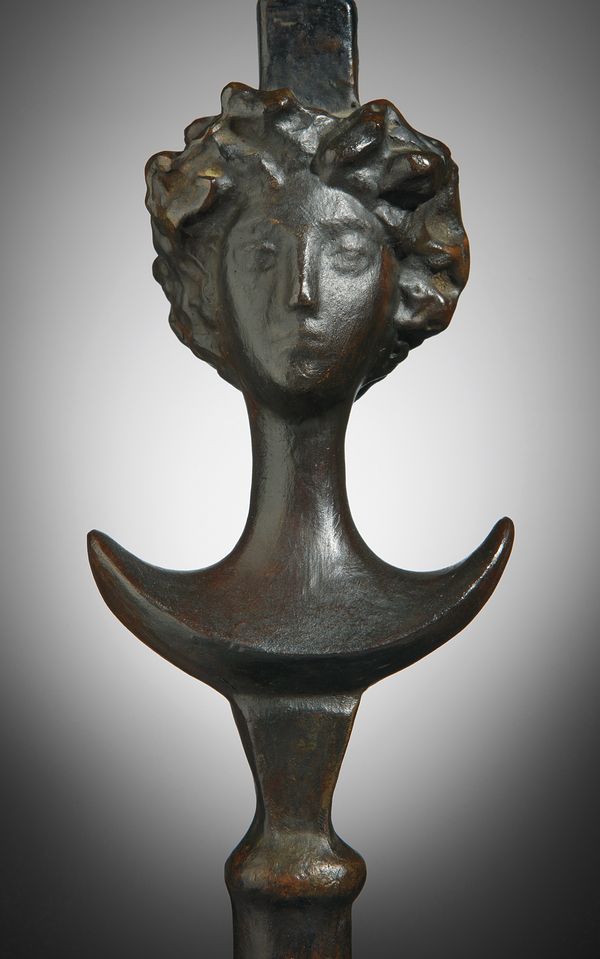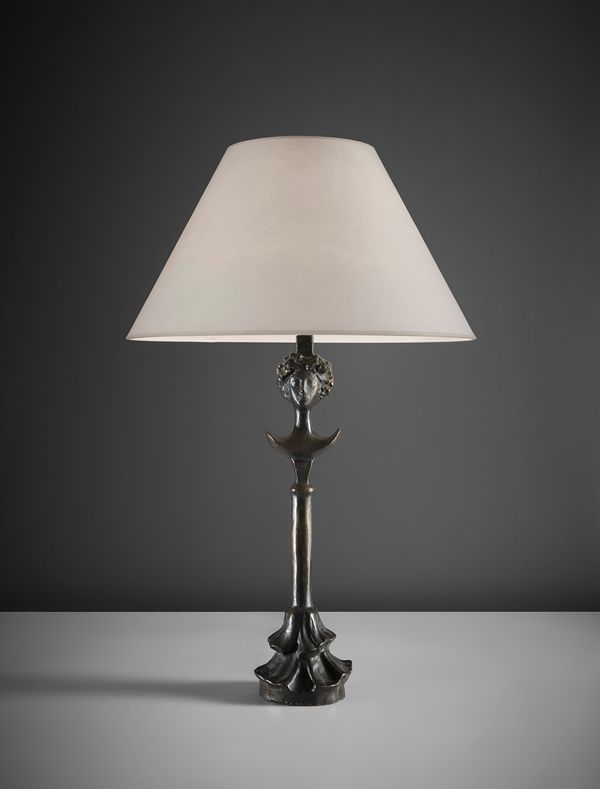Alberto Giacometti 'Tête de femme' table lamp, designed 1937 (detail)
Recalling elements of an architectural caryatid, the form of Alberto Giacometti's Tête de femme table lamp simultaneously features an unevenness and softness that reveals the artist's hand. The dark brown patina of the bronze gives the object a subtle richness, whilst enhancing its sculptural quality. The use of bronze also links the lamp to a second classical form, the bust — a theme that preoccupied Giacometti throughout his career.
However, it is the artistic intent behind the object's considered detail and simplicity that gives the modern work its value.
The Tête de femme lamp comprises part of the collection of decorative objects that Giacometti created for the influential interior designer Jean-Michel Frank between 1932 and 1940. These objects became integral to the designer's celebrated minimalist interiors, and Frank's fashionable clientele became great admirers of the sculptor's work. Frank positioned Giacometti's lamps and vases prominently throughout his stark interiors, which were renowned for such luxurious materials as leather, marble, ivory and parchment. Translating the spirit of Frank's 'anonymity' of forms and space, Giacometti worked from ancient forms. Giacometti traced the genesis of these forms, emptying them of their meaning, in order to retain only the essential.
Alberto Giacometti 'Tête de femme' table lamp, designed 1937
Evoking forms from ancient Greek, Roman and Egyptian excavations, Giacometti's decorative works reflect his admiration of these civilizations and his study of their utilitarian objects. However, devoid of any direct historical reference, these works retain a sense of mysterious anonymity, allowing the viewer to unconsciously construct the work's form and meaning. Giacometti had joined the Surrealists in 1931, and although he parted ways with the group by 1935, elements of the movement remained in his work. By the mid-1930s, Giacometti had returned his attention back to the depiction of the human figure, and specifically to the human head — the exploration of which would remain central to the artist's work throughout his life.
During this period, the British painter and designer Isabel Rawsthorne became one of Giacometti's primary models. Rawsthorne acted as a muse for several of her avant-garde contemporaries, and ultimately it is through these relationships that she has become largely remembered historically. Whilst the two artists developed a personal relationship, Giacometti and Rawsthorne shared artistic interests, including a commitment to a modern form of representational painting. Both artists were inspired by ancient figures, in particular Egyptian sculpture, which provided a model for Giacometti's exploration of the individual versus the universal. These interests are expressed in the formal simplicity of the Tête de femme lamp's totemic form, whilst the lamp's stylised face bears a resemblance to Rawsthorne, whose face Giacometti likened to that of an Egyptian head.
Lauren Bacall circa 1945 © John Kobal Foundation/ Getty images
Giacometti first conceived of his Tête de femme lamp in plaster around 1937, from which he later cast an edition in bronze. The original plaster model of the lamp is now held in the collection of the Museum of Decorative Arts in Paris.
This lot from our Modern Masters sale belonged to the American actress Lauren Bacall, who made her film debut in 1944 playing opposite Humphrey Bogart, her eventual husband. Through her roles as a film noir femme fatale, Bacall became an icon of Hollywood's Golden Age. It is largely through the mystique of this persona that Bacall, like Rawsthorne, is foremost celebrated. As modeled by ancient Egyptian artifacts, the individual has become an idealised universal symbol.
The inherent contrast of the archetypal recognition of the individual finds parallels in Giacometti's work; the anonymous and the specific, the ancient and the modern, and the functional and art object, are each evoked by Giacometti's Tête de femme.
This piece is registered by the Fondation Alberto and Annette Giacometti in the online Alberto Giacometti Database (AGD) under the number AGD 3497.


